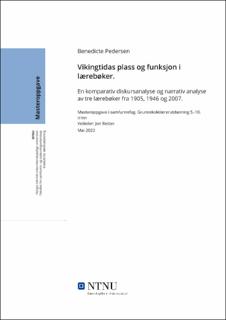| dc.contributor.advisor | Reitan, Jon | |
| dc.contributor.author | Pedersen, Benedicte | |
| dc.date.accessioned | 2022-07-23T17:21:30Z | |
| dc.date.available | 2022-07-23T17:21:30Z | |
| dc.date.issued | 2022 | |
| dc.identifier | no.ntnu:inspera:110859567:26312967 | |
| dc.identifier.uri | https://hdl.handle.net/11250/3008055 | |
| dc.description.abstract | Oppgaven er en narrativ analyse og diskursanalyse av hvilken plass og funksjon vikingtida har hatt i et utvalg norske lærebøker fra 1905 til 2007. Jeg har også undersøkt i hvilken grad utviklingen av dette henger sammen med den plassen og funksjonen som vikingtida har hatt i samfunnet ellers i samme tidsperiode.
Teorigrunnlaget for oppgaven er hovedsakelig Ola Svein Stugus historiebruksmodell (2016), som jeg aktivt bruker i analysen. Skolen er en viktig arena for norske barns oppvekst og samfunnsdeltakelse, og hvordan historien brukes i skolens lærebøker kan ha mye å si for elevenes utvikling av verdier og fordommer. I tillegg redegjør jeg for noen viktige begreper; historiebruk og historiebevissthet.
Jeg har gjort en narrativ analyse og en mer utdypende diskursanalyse av hver bok for seg, før jeg har sammenliknet og drøftet funnene fra hver analyse til slutt. Bøkene jeg har analysert er Det norske folks historie. Fortalt for folke- og ungdomsskolen (Lødøen, 1905), Historie for folkeskolen (Eriksen, 1946) og Midgard 6. samfunnsfag for barnetrinnet (Aarre m. fl., 2007). Alle bøkene er skrevet for den aldersgruppa vi i dag kaller mellomtrinnet.
Funnene fra analysen er tydelige; det har skjedd en endring i hvilken plass og funksjon som gis vikingtida i de tre lærebøkene, men ikke i samme tempo som i resten av samfunnet. I boka fra 1905 fant jeg at vikingtida og vikingene ble tillagt utelukkende positive egenskaper, og at perioden beskrives med stolthet. Særlig beskrivelsene av vikingkongene taler for dette. Periodens funksjon i denne boka er både nasjonsbyggende og misjonerende, de samme funksjonene som den hadde i samfunnet på denne tida.
Etter andre verdenskrig og nazistenes misbruk av vikingtida som periode, var oppmerksomheten rundt denne dempet, men dette kommer ikke til uttrykk i Eriksens lærebok fra 1946. Også i denne boka legges perioden fram med stolthet, og med en sterkt misjonerende funksjon.
I den nyeste boka, fra 2007, er stoltheten overfor vikingtida noe mindre framtredende. Den er skrevet i ei tid der det finnes mange varianter av vikingen, med mange ulike egenskaper. De fleste egenskapene som tillegges figuren og perioden i kulturen er dog positive, og det samme gjelder i Midgard 6. I denne boka er ikke vikingtida tillagt en misjonerende funksjon, men heller en demokratiserende. | |
| dc.description.abstract | This thesis is a narrative and discourse analysis of what place and function the Viking Age is given in a small selection of Norwegian school textbooks from 1905 to 2007. I have also examined whether the development of this is the same as in the Norwegian culture and society in the same period.
The theoretical foundation for the thesis is based in Ola Svein Stugus model for use of history (2016) that I actively use in the analysis. School is an important arena for Norwegians kids’ upbringing and participation in society, and how history is used in school textbooks affect the pupils’ development of values and prejudice. I also explain a few concepts; use of history and historical awareness.
I have done a narrative analysis and a more elaborate discourse analysis of each book, and then compared and discussed the findings of each analysis in the end. The books I have analyzed are Det norske folks historie. Fortalt for folke- og ungdomsskolen (Lødøen, 1905), Historie for folkeskolen (Eriksen, 1946) and Midgard 6. samfunnsfag for barnetrinnet (Aarre m. fl., 2007). They are all written for pupils within the age of 10-14 years.
The findings are clear; there has been development in terms of what place and function the Viking Age has been given in the three books, but not in the same pace as in society. In the 1905 book, I found that the Viking Age and the Vikings are presented with exclusively positive characteristics, and that the period is described with pride. Especially the descriptions of the Viking kings support this. The period’s function in this book is both missionary and serves a purpose of building the Norwegian nation, the same functions av it had in society during this time.
After the second World War and the nazis’ misuse of the Viking Age, the attention around the period was muted, but this does not come to show in Eriksen’s textbook from 1946. In this book, too, the period is presented with pride, and with a strongly missionary function.
In the newest of the three books, from 2007, the pride presented in the earlier books is less showing. It is written in a time where the representations of the Vikings are many, all with different characteristics. Most of the characteristics associated with the Vikings are positive, though, and the same goes for the representations in Midgard 6. In this book, the Viking Age is not given a missionary function, but instead a democratizing one. | |
| dc.language | nob | |
| dc.publisher | NTNU | |
| dc.title | Vikingtidas plass og funksjon i lærebøker. En komparativ diskursanalyse og narrativ analyse av tre lærebøker fra 1905, 1946 og 2007. | |
| dc.type | Master thesis | |
